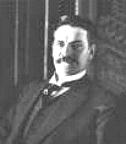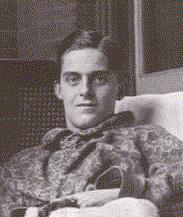

For many years there has been conflicting and contradictory information regarding the exact manner in which the Titanic's chief Marconi operator John Phillips met his death. Many researchers have expressed the belief that Phillips died of exposure after crawling on board the upturned Collapsible B, this opinion being based on evidence that was provided by junior Marconi operator Harold Bride and Second Officer Charles Lightoller.
A careful reading of the available evidence, however, reveals that Bride's and Lightoller's so-called 'eyewitness' accounts of Phillips' death do not really prove what some researchers *believe* they prove.
Let us take a closer look at the evidence in question.

Following his rescue by the Carpathia, Harold Bride provided the Marconi Company with an official account of his and Phillips' activities on board the Titanic and of their last hours together before the vessel sank. Bride's account had this to say about the last time he saw Jack Phillips:
"Leaving the cabin, we climbed on top of the houses comprising the officers' quarters and our own, and here I saw the last of Mr. Phillips, for he disappeared walking aft."
The reader will note that Harold Bride did not qualify his statement by saying he last saw Jack Phillips *alive* at that time, so we must take Bride at his word that this was the *very last* time he saw Phillips either alive or dead. This is confirmed by Bride's later statement that he did not actually *see* Jack Phillips on the overturned collapsible lifeboat upon which Bride himself took refuge; Bride said: "I called Phillips several times, but got no response, but learned later from several sources that he was on this boat and expired even before we were picked off by the Titanic's boat."
Harold Bride had a bit more to say about this matter during his exchange with Senator Smith, which is contained on page 162 of the Senate Inquiry:
Smith: You say there were a number of people on the boat, on the bottom of the boat that was bottom-up when you got there?
Bride: Yes.
Smith: Do you know any of them?
Bride: Mr. Phillips.
Smith: Was on the boat?
Bride: Yes; I heard so afterwards.
Smith: He did not survive, however?
Bride: He did not survive.
Smith: Do you know whether he died going from the Titanic to the Carpathia?
Bride: He died on the way, yes. He died on board the upturned boat.
Smith: What became of his body?
Bride: As far as I know, it was taken on board the Carpathia and buried from the Carpathia.
Smith: Buried at sea?
Bride: Buried from the Carpathia.
Smith: Did anyone else die on that boat between the wreck and the Carpathia?
Bride: There was a man lying aft that they said was dead when they took him onto the ship's boat.
Smith: What did they do with his body?
Bride: He was taken on board the Carpathia as far as I know.
As the above testimony makes clear, Harold Bride reaffirms that he was merely *told* that Jack Phillips was on board the upturned collapsible and that he never actually saw Phillips there himself.

A contrary viewpoint, however, was presented in Second Officer Charles Lightoller's 1934 autobiography, "Titanic and Other Ships." Lightoller's autobiographical account is very detailed, and his account of Jack Phillips' presence on board the overturned collapsible sounds so convincing that readers could easily be forgiven for believing the account to be completely accurate and authoritative. Lightoller says:
"Phillips, the senior wireless operator, standing near me, told me the different ships that had answered our call . . . . poor old Phillips did not live to benefit by it. He hung on till daylight came in and we sighted one of the lifeboats in the distance . . . . he suddenly slipped down, sitting in the water, and though we held his head up he never recovered. I insisted on taking him into the lifeboat with us." [Lightoller, pp. 252-3.]
As with so much of Lightoller's 1934 information, however, his latter-day claims about Jack Phillips are contradicted elsewhere and must be taken with a huge grain of salt. Archibald Gracie's book ("The Truth About the Titanic," which - unlike Lightoller's book - was written very shortly after the disaster when memories were still fresh) says:
"Among the number, we are told by Bride and Whiteley, was the senior Marconi operator, Phillips, but their statement that it was Phillips' lifeless body which we transferred first to a lifeboat and thence to the Carpathia is a mistake, for the body referred to both Lightoller and myself know to have been a member of the crew, as described later . . . . When the presence of the Marconi boy at the stern [i.e. Harold Bride] was made known, Lightoller called out, from his position at the bow, questions which all of us heard, as to the names of the steamships with which he had been in communication for assistance. We on the boat recall the names mentioned by Bride . . . . When my turn came [to transfer from the collapsible to the lifeboat] I went carefully . . . . Lightoller remained to the last, lifting a lifeless body into the boat beside me . . . . He was dressed like a member of the crew . . . . Lightoller was uncertain as to which one he was of two men he had in mind; but we both knew that it was not the body of Phillips, the senior Marconi operator." [Gracie, pp. 98 - 108.]

Gracie also refers to Lightoller's 1912 inquiry testimony and quotes it as follows:
"I think there were three or four who died during the night aboard our boat. The Marconi junior operator told me that the senior operator was on this boat and died, presumably from the cold." [Gracie, p. 98.]
It is clear from Gracie's account that the wireless operator who cheered up the occupants of the upturned collapsible by calling out the names of approaching ships was Harold Bride, not Jack Phillips (as Lightoller thought in 1934.) It is also clear from the accounts of Gracie and Lightoller that only one body was transferred from the collapsible onto boat #12. Bride stated that he knew the body of "the man lying aft" was transferred to #12 -- which was undoubtedly the body of the crewman mentioned by Gracie and which Lightoller (in 1912) *agreed* was the body of a crewman. Harold Bride's assumption that the bodyof Phillips (which he never saw) was *also* taken on board the Carpathia was just that -- an assumption (since he obviously did not see Phillips' body laying abandoned in #12 after the boat was emptied of living passengers.)
So, in the end, what we have is this: in 1912 Lightoller testified that Bride *told* him that Phillips was on the collapsible. In 1912 Bride said *he* was told that Phillips had been on the collapsible. In other words, in 1912 *neither* Lightoller nor Bride knew *first hand* that Phillips had been on the collapsible. In addition, in 1912 Gracie said that the dead man on the collapsible was a crewman and that, at that time, Lightoller agreed with him.
By 1934, however, Second Officer Lightoller's story had become much more elaborate; by that time his conversation with Harold Bride on board the collapsible had 'changed' into a conversation with Jack Phillips, and the body of the dead crewman had changed into the body of Phillips himself.
When it comes right down to it, the only person we know of who supposedly claimed to have *seen* Jack Phillips on board the upturned collapsible was steward Thomas Whiteley. In one newspaper interview Whiteley was quoted as saying that Phillips was on board the collapsible with him and spoke about the approaching ships before losing consciousness and dying. According to Whiteley's interview, Phillips' body was supposedly taken on board the Carpathia. (This information is so similar to the story Bride was told about Phillips that it is possible Whiteley was Bride's source of information about Phillips' death.)

However, another newspaper interview with Thomas Whiteley states that Jack Phillips was in one of the five lifeboats that were lashed together. Phillips supposedly sank down into the bottom of the boat and died despite efforts to revive him, and his body was "washed overboard" a little later.
It is well known that newspaper interviews often leave a great deal to be desired as far as accuracy goes. We know (via Gracie) that Phillips' body was not taken on board the Carpathia from the upturned collapsible, nor is there any evidence to suggest that Phillips was picked up by one of the boats that were lashed together. In short, the information provided by Thomas Whiteley concerning the death of Jack Phillips is uncorroborated and is therefore of unknown reliability. Perhaps Whiteley saw Jack Phillips die on the overturned collapsible, or perhaps he didn't. What we *do* know, though, is that neither Harold Bride nor Charles Lightoller actually *saw* Phillips on board the upturned collapsible that night.
Sadly, this is probably as close to solving the mystery of Jack Phillips' death as we will ever come.